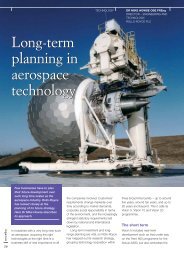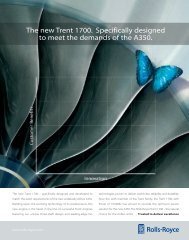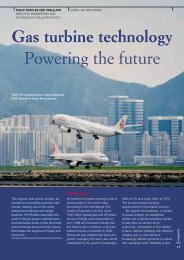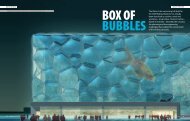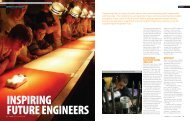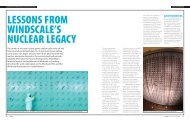Thousands of UK schools are now running after-school ... - Ingenia
Thousands of UK schools are now running after-school ... - Ingenia
Thousands of UK schools are now running after-school ... - Ingenia
You also want an ePaper? Increase the reach of your titles
YUMPU automatically turns print PDFs into web optimized ePapers that Google loves.
SOCIETY<br />
AFTER-SCHOOL<br />
CLUBS<br />
<strong>Thousands</strong> <strong>of</strong> <strong>UK</strong> <strong><strong>school</strong>s</strong> <strong>are</strong> <strong>now</strong> <strong>running</strong> <strong>after</strong>-<strong>school</strong> clubs<br />
that give young people sustained, positive experiences <strong>of</strong> the<br />
creative excitement that engineering and technology can provide.<br />
<strong>Ingenia</strong> recently contacted hundreds <strong>of</strong> <strong><strong>school</strong>s</strong> asking about<br />
their experience <strong>of</strong> <strong>running</strong> these clubs and specifically about<br />
programming physical devices. Scott Steedman, Editor-in-Chief <strong>of</strong><br />
<strong>Ingenia</strong>, and Anna Paczuska, an education researcher and writer,<br />
considered the responses and give an overview <strong>of</strong> <strong>after</strong>-<strong>school</strong><br />
club activity.<br />
Brighton College Prep School: their Young Engineers club engineered a series <strong>of</strong> modifications to a wind turbine blade<br />
to improve their <strong>school</strong>’s carbon footprint<br />
A new crop <strong>of</strong> <strong>after</strong>-<strong>school</strong><br />
engineering and technology<br />
clubs has sprung up across the<br />
<strong>UK</strong> in the past decade. These<br />
clubs <strong>are</strong> aimed not just at older<br />
pupils already committed to<br />
studying engineering or other<br />
STEM (science, technology,<br />
engineering and mathematics)<br />
subjects, but also at younger<br />
secondary and even primary<br />
pupils. Some extraordinary<br />
projects have been undertaken,<br />
ranging from building a plane to<br />
developing applications for ‘smart’<br />
textiles. Clubs have emerged in<br />
many different types <strong>of</strong> <strong>school</strong>,<br />
with gender being no barrier to<br />
access or success. Many clubs <strong>are</strong><br />
diverse and inclusive, organised<br />
by staff motivated to increase<br />
the take-up <strong>of</strong> STEM subjects at<br />
all stages in the curriculum and<br />
perhaps even to stimulate more<br />
young people towards a related<br />
c<strong>are</strong>er.<br />
INGENIA ISSUE 50 MARCH 2012 1
AFTER-SCHOOL CLUBS<br />
SOCIETY<br />
SUPPORTING STEM TEACHING<br />
AND LEARNING<br />
The Engineering Engagement Programme run by The Royal<br />
Academy <strong>of</strong> Engineering has delivered continual pr<strong>of</strong>essional<br />
development training to over 180 <strong><strong>school</strong>s</strong> and teachers across<br />
the <strong>UK</strong>. Through this project, <strong><strong>school</strong>s</strong> have been provided<br />
with resources and activities to support and develop their<br />
engineering clubs. Teaching resources have been developed by<br />
the Academy, with activities including designing packaging with<br />
thermochromatic pigment to ensure safe food storage, making<br />
plastics from milk and devising applications for new materials.<br />
STEM activities <strong>are</strong> also developed by the Academy, exemplified<br />
by the classroom resource ‘Athlete or Machine?’ This investigation<br />
into the science, technology, engineering and mathematics behind<br />
the bob skeleton provides a truly cross-curricular activity, with realworld<br />
applications to Olympic sport. Students <strong>are</strong> challenged to<br />
design, build and test a model bob skeleton, while optimising for<br />
maximum speed and minimum aerodynamic drag.<br />
The Academy continues to develop and disseminate resources<br />
through its own networks. It also works closely with STEMNET to<br />
support and encourage STEM ambassadors to engage actively<br />
with <strong><strong>school</strong>s</strong> in delivering and developing engineering projects.<br />
A programme <strong>of</strong> working with teacher coordinators is actively<br />
developing networks with <strong><strong>school</strong>s</strong> not previously engaged with STEM<br />
activities. More information at www.raeng.org.uk/education/eenp/<br />
North London STEM Club participants extracting plastic from milk. Students<br />
heated up whole milk before adding vinegar, causing the protein caesin to<br />
precipitate out <strong>of</strong> the milk as a white solid. Caesin is a long-chain molecule,<br />
or polymer, and the students were encouraged to mould the solid into<br />
different shapes, thereby making a comparison with other plastics<br />
The approach adopted by<br />
the vast majority <strong>of</strong> clubs is to<br />
engage young people in ‘real<br />
world’ activities, <strong>of</strong>ten using the<br />
latest technologies, to build or<br />
create something that works.<br />
This has enabled thousands <strong>of</strong><br />
young people to see the study<br />
<strong>of</strong> STEM subjects as fun, exciting<br />
and relevant. Club leaders <strong>are</strong><br />
consistent in their view that<br />
projects should be based on<br />
themes or activities chosen by<br />
the students themselves and that<br />
they should be ‘hands-on’ and<br />
closely related to what they can<br />
see and experience in the world<br />
around them.<br />
Building eco-friendly<br />
buildings or ‘green’ cars have<br />
been popular choices for clubs,<br />
as has the never-ending interest<br />
in programming machines to<br />
race each other, climb over<br />
obstacles or carry out robotic<br />
tasks. Remote-controlled<br />
cars, jitterbugs and buggies<br />
<strong>are</strong> commonplace, while<br />
rockets continue to fire the<br />
imagination. In a nod to the<br />
television programme Scrapheap<br />
Challenge, at least one club has<br />
built go-karts from old bicycle<br />
frames. Some clubs have<br />
gone even further combining<br />
‘classroom’ projects with a wider<br />
interaction with their <strong>school</strong> or<br />
local community based on ideas<br />
related to medicine, health, and<br />
consumer products, such as<br />
clothing.<br />
BUILDING<br />
CONTROLLABLE<br />
DEVICES<br />
One major advance in recent<br />
years has been the availability <strong>of</strong><br />
cheap programmable devices<br />
that allow students to design<br />
and make devices that produce<br />
computer-controlled movement.<br />
These allow pupils to experience<br />
the concept <strong>of</strong> a programming<br />
language and how logic may<br />
be used to structure a series<br />
<strong>of</strong> commands that control<br />
mechanical devices.<br />
Controlling movement in<br />
a machine can be achieved<br />
using a simple Peripheral<br />
Interface Controller (PIC) or more<br />
advanced microprocessors.<br />
Microchips <strong>of</strong>fer a useful<br />
introduction to programming<br />
without the need for expensive<br />
computer suites. To make things<br />
easier, a range <strong>of</strong> commercially<br />
supplied kits <strong>are</strong> <strong>now</strong> readily<br />
available, comprising simple<br />
programmable devices with<br />
s<strong>of</strong>tw<strong>are</strong> for as little as £2 each.<br />
School clubs <strong>are</strong> also able<br />
to purchase reasonably priced<br />
microcontroller systems that<br />
help with an introduction to<br />
programming. PICAXE is a<br />
<strong>UK</strong>-sourced system based on<br />
a standard PIC microcontroller<br />
chip. Arduino is an opensource<br />
(free to use and develop)<br />
single-board microcontroller.<br />
Both systems <strong>are</strong> designed to<br />
make the process <strong>of</strong> controlling<br />
electromechanical devices more<br />
accessible to people with limited<br />
or no programming experience.<br />
Schools also reported using the<br />
GENIE 8-pin microcontroller<br />
system, the Micros<strong>of</strong>t .NET<br />
Gadgeteer open-source toolkit<br />
and Lego Mindstorms.<br />
The next stage is to consider<br />
more sophisticated systems<br />
such as the $25 Raspberry Pi,<br />
a credit-card-sized computer<br />
that can connect a television<br />
monitor, keyboard and other<br />
peripherals via a USB hub.<br />
Despite its small size, each unit<br />
packs considerable processing<br />
power and can be used as part<br />
<strong>of</strong> a toolkit for young people<br />
interested in learning about<br />
IMAGINEERING CLUBS<br />
Imagineering Clubs provide<br />
hands-on activities for one<br />
hour a week throughout the<br />
academic year to groups <strong>of</strong><br />
around 12 pupils. Most <strong>of</strong><br />
these out-<strong>of</strong>-<strong>school</strong> clubs<br />
<strong>are</strong> run by engineer tutors,<br />
providing real-life experiences<br />
<strong>of</strong> engineering. Offering a<br />
sustained programme <strong>of</strong><br />
development throughout the<br />
academic year, sitting alongside<br />
the National Curriculum, they<br />
cover subjects as diverse as<br />
electricity, magnetism, flight<br />
and measurement. Where<br />
possible, the youngsters <strong>are</strong><br />
taken on visits to factories and<br />
other engineering facilities to<br />
experience modern engineering<br />
and technology in action.<br />
Bob Young is a retired<br />
engineer and volunteer tutor<br />
at a long-<strong>running</strong> Imagineering<br />
Club at St Richard’s Church <strong>of</strong><br />
England First School in Evesham,<br />
Worcestershire. He finds that as<br />
well as gaining practical skills,<br />
the children <strong>are</strong> able to grasp<br />
how things work and the science<br />
and technology behind each<br />
model. The youngsters learn to<br />
read drawings, use checklists,<br />
organise their work surfaces and<br />
the disciplines associated with<br />
these activities, gaining personal<br />
confidence and a sense <strong>of</strong><br />
achievement by learning through<br />
this practical experience.<br />
Elizabeth Spencer, Head<br />
Teacher at St Richard’s, says that<br />
the involvement with engineers<br />
and the opportunities for the<br />
pupils to visit engineering works<br />
has also proved beneficial with<br />
pupils gaining in confidence<br />
and becoming enthusiastic<br />
about engineering as a result.<br />
More information at<br />
www.imagineering.org.uk<br />
A youngster at an Imagineering Club at St Richard’s Church <strong>of</strong> England First School in Evesham constructs a Morse key<br />
and buzzer using simple tools and learns the principles <strong>of</strong> electro-magnetism through practical experience<br />
© The Imagineering Foundation<br />
2 INGENIA INGENIA ISSUE 50 MARCH 2012 3
AFTER-SCHOOL CLUBS<br />
SOCIETY<br />
The STEM Clubs Support team based at the British Science<br />
Association reports that across the <strong>UK</strong> some 2,200 <strong><strong>school</strong>s</strong> <strong>are</strong> part<br />
<strong>of</strong> the STEM clubs network with new affiliations being made daily.<br />
BUILDING BRIDGES<br />
Class teacher Peter Davison started a lunchtime engineering club at Victoria Junior School in Barrowin-Furness<br />
in 2010. The club meets once a week, has 25 members (Davison says he could have had<br />
50, such was the interest) and is supported by the Barrow Engineering Project which provided the<br />
club with ambassadors from BAE Systems. Activities have so far centred on building different kinds<br />
<strong>of</strong> bridges and testing them. This also meets the needs <strong>of</strong> the National Curriculum which requires<br />
children to design something that takes weight, and suggests an object such as a chair.<br />
Most recently the children have designed and built motor- and wind-powered vehicles and their<br />
next project is to design a house. Davison says projects must be relevant to children’s everyday lives<br />
and the more that they involve pupils’ interests and hobbies the better, such as scooters, skateboards<br />
and indeed anything they see as ‘cool’.<br />
Victoria Junior School Engineering Club Children race motorised buggies that they have designed and put together<br />
themselves © Davison<br />
programming for operating<br />
systems such as Linux, and in<br />
developing games or controlling<br />
sensors.<br />
PROGRAMMING<br />
SKILLS<br />
One barrier to the introduction<br />
<strong>of</strong> programming reported by<br />
some <strong><strong>school</strong>s</strong> has been the<br />
tendency for <strong>after</strong>-<strong>school</strong> clubs<br />
to be organised by Design &<br />
Technology (D&T) departments,<br />
whose teachers sometimes<br />
lack the programming skills to<br />
exploit these new opportunities<br />
effectively with their students.<br />
A survey by the Design and<br />
Technology Association (DATA, a<br />
body representing D&T teachers)<br />
found that only a small fraction<br />
<strong>of</strong> D&T departments were<br />
teaching this part <strong>of</strong> the D&T<br />
syllabus. The Royal Academy<br />
<strong>of</strong> Engineering subsequently<br />
developed two pr<strong>of</strong>essional<br />
development courses for<br />
teachers, ‘Let’s Make It Work’<br />
and ‘Let’s Make It Move’, which<br />
<strong>are</strong> delivered by Science<br />
Learning Centres across the<br />
<strong>UK</strong>. These courses focus on<br />
the physical, as well as virtual<br />
outcomes that can be achieved<br />
through programming and<br />
enable teachers to introduce<br />
programming activities to their<br />
classrooms.<br />
FUNDING AND<br />
OUTSIDE SUPPORT<br />
Many <strong>after</strong>-<strong>school</strong> engineering<br />
clubs began with some kind <strong>of</strong><br />
project funding at the outset<br />
and have continued by using a<br />
combination <strong>of</strong> <strong>school</strong> funding,<br />
sponsorship and contributions<br />
from p<strong>are</strong>nts. At one end <strong>of</strong> the<br />
scale, North East Wolverhampton<br />
Academy has launched a twoyear<br />
project with Boeing to<br />
build and fly a two-seat microlight<br />
plane at a cost <strong>of</strong> £40,000<br />
in conjunction with the Royal<br />
Aeronautical Society and Light<br />
Aircraft Association, which <strong>are</strong><br />
providing support in kind.<br />
However, it is not necessary<br />
to spend such large sums to<br />
achieve remarkable results.<br />
Guiseley School in Bradford<br />
has found success in building<br />
go-karts from old bicycles and<br />
collaboration on its robotic<br />
projects with Bradford Model<br />
Engineering Club, approaching<br />
local businesses for support.<br />
In fact, a vast array <strong>of</strong><br />
resources, many <strong>of</strong> them free<br />
<strong>of</strong> charge or low-cost, has<br />
been developed by a range<br />
<strong>of</strong> providers to support club<br />
activities. They include kits<br />
and activity sheets on every<br />
aspect <strong>of</strong> engineering and<br />
STEM ambassador networks <strong>of</strong><br />
employees from industry and<br />
students from universities who<br />
visit <strong><strong>school</strong>s</strong> to support club<br />
activities. C<strong>are</strong>er websites, such<br />
as Future Morph, competitions<br />
(such as Young Engineers’ Club<br />
Competition and First Lego<br />
League) and award schemes<br />
for pupils, and start-up funding<br />
for projects <strong>are</strong> all available to<br />
support club leaders.<br />
CLUBS INCREASING<br />
IN POPULARITY<br />
The first big push towards<br />
bolstering club activity numbers<br />
came from the governmentfunded<br />
After School Science<br />
and Engineering Clubs (ASSEC)<br />
programme which ran between<br />
2007 and 2009 and aimed to<br />
set up 250 <strong>after</strong>-<strong>school</strong> clubs<br />
across England and Wales.<br />
Government funding following<br />
the recommendations <strong>of</strong> Lord<br />
Sainsbury in his 2007 report Race<br />
GREENPOWER CAR RACE<br />
The St Mark’s Young Engineers Club has been <strong>running</strong> since 2001.<br />
Initially it was started to enter the Greenpower electric car race. The<br />
club members continue to use the Young Engineers Club Network<br />
to select a range <strong>of</strong> local and national competitions to spur them on.<br />
Damian Smeaton, the <strong>school</strong>’s Technology Teacher and Club’s Leader<br />
helps the students make solar buggies for the Toyota Technology<br />
Challenge. The club also enters the NPL Water Rocket Challenge and<br />
British Schools Karting Championship, as well as entering several <strong>of</strong><br />
Young Engineers’ own challenges every year.<br />
Like so many clubs, it is their Design & Technology technician,<br />
Phil Woodhams, who is pivotal to the club’s ongoing momentum<br />
and impact. The competitions have enhanced the <strong>school</strong> pr<strong>of</strong>ile<br />
with some local press coverage and they have involved some feeder<br />
primary <strong><strong>school</strong>s</strong> in their activities. They currently have 25 students<br />
including several girls.<br />
Young Engineers have a range <strong>of</strong> club resources available to<br />
download at www.youngeng.org/index.asp?page=1203<br />
to the Top was a key element<br />
in the subsequent success<br />
<strong>of</strong> the programme, which<br />
was managed by STEMNET, a<br />
government-funded body set<br />
up to support STEM initiatives<br />
in <strong><strong>school</strong>s</strong>. The programme<br />
targeted secondary <strong>school</strong><br />
pupils with a view to improving<br />
their performance at Key<br />
Stage Three (years 7, 8 and<br />
9) in science subjects and to<br />
encourage them to consider<br />
c<strong>are</strong>ers in engineering and<br />
science.<br />
Since 2009, participation<br />
in <strong>after</strong>-<strong>school</strong> engineering<br />
and STEM clubs has increased<br />
more than threefold. Indeed,<br />
the number <strong>of</strong> clubs in the<br />
STEM Clubs network has risen<br />
from 500 in 2009 to around<br />
2,200 <strong><strong>school</strong>s</strong> today, with new<br />
affiliations being made daily.<br />
Operating alongside<br />
STEMNET <strong>are</strong> programmes<br />
such as Imagineering, the<br />
independent education<br />
charity that takes part in a<br />
number <strong>of</strong> engineering fairs<br />
and supports over 150 <strong>after</strong><strong>school</strong><br />
clubs led by volunteer<br />
engineers, and Young Engineers,<br />
an organisation that also<br />
supports a national network<br />
<strong>of</strong> engineering clubs as well<br />
as other activities such as<br />
challenges and competitions<br />
Young Engineers <strong>now</strong> has 1,800<br />
clubs on their register. Most<br />
<strong>of</strong> these <strong>are</strong> in state <strong><strong>school</strong>s</strong>,<br />
and around four new clubs<br />
join the network every week.<br />
The average Young Engineers<br />
club has some 21 members,<br />
a third <strong>of</strong> whom <strong>are</strong> girls, and<br />
students <strong>are</strong> involved in clubs<br />
for around two years at a time.<br />
Additional outreach activities<br />
such as The Big Bang Fair and<br />
the Tomorrow’s Engineers<br />
initiative (a partnership between<br />
Engineering<strong>UK</strong> and the<br />
Academy) involve an estimated<br />
50,000 secondary pupils. The<br />
Imagineering Fair, with hands-<br />
St Mark’s Young Engineers Club’s Greenpower team on race day<br />
4 INGENIA INGENIA ISSUE 50 MARCH 2012 5
AFTER-SCHOOL CLUBS<br />
SOCIETY<br />
CARBON ZERO<br />
Four years ago Cathie Serrao, Head <strong>of</strong> Science at Queens’ School,<br />
a sports and science college in Hertfordshire, identified a need to<br />
raise the pr<strong>of</strong>ile <strong>of</strong> STEM subjects in her <strong>school</strong>. This led to a bid for<br />
funds for an eco-project to build an outdoor classroom to promote<br />
STEM subjects. Both Cathie and Sue Taplin, a Design & Technology<br />
teacher and a Forest School Leader, ran a club called ‘Carbon Zero’<br />
for Year 8 pupils, which engaged students in various aspects <strong>of</strong> the<br />
environment. The club members constructed the outdoor shelter;<br />
it involved groups <strong>of</strong> 16 pupils at a time, the majority girls, in<br />
lunchtime and <strong>after</strong> <strong>school</strong> sessions.<br />
Now that the classroom is finished it has become home<br />
to a range <strong>of</strong> other clubs including a Year 8 Engineering Club<br />
and ‘i:Wood’. The sessions incorporate STEM subjects through a<br />
culmination <strong>of</strong> various holistic teaching methods; exploration<br />
through playful experiences, managing risk with a student-led focus<br />
and time for reflection on learning. Serrao, says the whole project<br />
has resulted in a massive increase <strong>of</strong> interest in STEM including a<br />
50% increase in the take up <strong>of</strong> A- level Science and Product Design.<br />
on engineering activities and<br />
opportunities for students to<br />
meet young, working engineers,<br />
attracts over 100,000 visitors<br />
annually.<br />
MEASURES OF<br />
SUCCESS<br />
From the bath bombs <strong>of</strong> St<br />
Boniface’s College to the model<br />
cyclotron at Orangefield High<br />
School, Belfast, our survey has<br />
found that whether a club is<br />
successful or not from the pupils’<br />
perspective seems to depend<br />
primarily on the confidence and<br />
commitment <strong>of</strong> the teacher or<br />
club leader and the support they<br />
can muster from local engineers<br />
and sponsors. From a national<br />
perspective, whether the <strong>after</strong><strong>school</strong><br />
club model is successful<br />
or not depends not just on the<br />
activities and their relevance<br />
to the real world, nor with the<br />
number <strong>of</strong> pupils attending and<br />
their app<strong>are</strong>nt enthusiasm, but<br />
on whether the clubs make any<br />
real difference to the way pupils<br />
think about STEM.<br />
There is plenty <strong>of</strong> supporting<br />
evidence to show that these<br />
clubs do indeed make an<br />
impact. Some club leaders<br />
quoted figures <strong>of</strong> 50% increased<br />
take-up <strong>of</strong> A-level Science and<br />
Product Design, which must be<br />
a positive short term indicator.<br />
Above all, though, the<br />
value <strong>of</strong> <strong>after</strong>-<strong>school</strong> clubs<br />
that have a technical bias<br />
appears to lie in the increased<br />
motivation <strong>of</strong> the pupils and<br />
teachers towards a common<br />
understanding, firstly <strong>of</strong><br />
engineering as a function, and<br />
secondly <strong>of</strong> engineering as a<br />
c<strong>are</strong>er. The active involvement<br />
<strong>of</strong> major industry must also<br />
Students at Queens’ School laying the wood chippings for the path that<br />
leads to the outdoor classroom shelter<br />
play a role. The opportunity<br />
to strengthen the traditional<br />
model <strong>of</strong> engineering clubs<br />
to include programming skills<br />
could yet see a further step<br />
up in interest and numbers<br />
across the country. Maltby<br />
Academy, whose girls have<br />
been developing projects for<br />
people with disabilities and<br />
who have <strong>now</strong> set up their<br />
own company and <strong>are</strong> talking<br />
to manufacturers, is surely an<br />
exemplar. There is no more<br />
powerful outcome that <strong>after</strong><strong>school</strong><br />
engineering clubs could<br />
deliver than to stimulate the<br />
entrepreneurs <strong>of</strong> tomorrow.<br />
Good progress has been<br />
made. Now we must promote<br />
the key ingredients for success in<br />
<strong>after</strong>-<strong>school</strong> clubs: incorporating<br />
sponsorship from industry,<br />
the integration <strong>of</strong> s<strong>of</strong>tw<strong>are</strong><br />
programming and a focus on<br />
entrepreneurial skills.<br />
BIOGRAPHY<br />
Anna Paczuska is an education researcher and writer. She<br />
taught mathematics and numeracy at <strong><strong>school</strong>s</strong> and colleges<br />
in inner London and then managed a series <strong>of</strong> wideningaccess<br />
initiatives including a BP-funded Access to Science<br />
and Maths project. She was Head <strong>of</strong> Access and Widening<br />
Participation at London South Bank University.<br />
The opportunity to strengthen the<br />
traditional model <strong>of</strong> engineering clubs to<br />
include programming skills could yet see<br />
a further step up in interest and numbers<br />
across the country.<br />
<strong>Ingenia</strong>’s Editor-in-Chief would<br />
like to thank the following<br />
<strong><strong>school</strong>s</strong> for responding to the<br />
magazine’s appeal for <strong>after</strong><strong>school</strong><br />
clubs information.<br />
Their input allowed a range<br />
<strong>of</strong> practical experiences to be<br />
included in this article.<br />
Thanks to: Notre Dame Roman<br />
Catholic School, Plymouth; The<br />
Glasgow Academy; St Boniface’s<br />
College, Plymouth; Langley<br />
Park School for Boys, London;<br />
King’s School in Macclesfield;<br />
Orangefield High School,<br />
Belfast; Appleton Academy,<br />
Bradford; Ralph Allen School,<br />
Bath; Framwellgate School<br />
Durham; Guiseley School, Leeds;<br />
Nova Hreod School, Swindon;<br />
Bury Grammar School for<br />
Girls; Keswick School; Keswick<br />
Thorpe Hall School; Thorpe Bay<br />
Hanham High School, Bristol;<br />
Cottingham High School, North<br />
Humberside; Bishop’s Stortford<br />
College; Bishop’s Hatfield Girls’<br />
School; Dame Alice Owens<br />
School, Potters Bar; Maltby<br />
Academy, Rotherham; Portslade<br />
Aldridge Community Academy,<br />
Brighton; Friern Barnet School,<br />
North London; Ernesford Grange<br />
Community College a Science<br />
Specialist School, Coventry;<br />
The King’s School, Canterbury;<br />
Queens’ School, Hertfordshire;<br />
Alperton Community School,<br />
London; Witton Park High<br />
School, Lancashire and South<br />
Camden Community School,<br />
London.<br />
AWARD WINNERS<br />
The STEM Club at Framwellgate School Durham was started four<br />
years ago for pupils at Key Stage 3. The club <strong>now</strong> has 75 members,<br />
including some year 10 pupils who were part <strong>of</strong> the original cohort<br />
and enjoyed it so much that they did not want to leave. Enterprise<br />
and STEM Enrichment Manager Catherine Purvis-Mawson<br />
expanded the club to allow these older pupils positions <strong>of</strong> greater<br />
leadership, managing project teams <strong>of</strong> younger pupils. She is also<br />
developing an internship programme for sixth form students to<br />
experience real-world placements in science and engineering.<br />
Some <strong>of</strong> the club’s activities include building a glider and<br />
developing experiments to test its aerodynamic efficiency and<br />
constructing devices based on electric circuits to improve the life<br />
<strong>of</strong> people with disabilities. Last year, the club organised a <strong>school</strong>wide<br />
design competition for applications <strong>of</strong> ‘smart’ materials<br />
in clothing, including Kevlar, thermographic, and UV-sensitive<br />
materials, culminating in a catwalk show with the announcer<br />
explaining the engineering principles behind each garment.<br />
This year, club members <strong>are</strong> collaborating with a partner <strong>school</strong><br />
in Jordan to design systems to conserve, re-use, and recycle water<br />
in the desert.<br />
Last year, the club won the Young Engineers’ problem-solving<br />
award at last year’s Big Bang Fair, and a STEMNET award for being<br />
‘the most dedicated club’. As a prize, five pupils will be travelling to<br />
CERN in Switzerland in March 2012.<br />
Students from Framwellgate School Durham wear the clothes that they<br />
made from ‘smart’ materials<br />
6 INGENIA INGENIA ISSUE 50 MARCH 2012 7



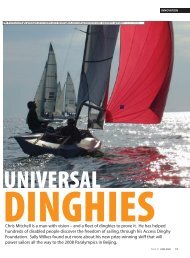

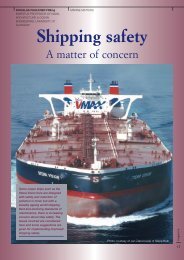
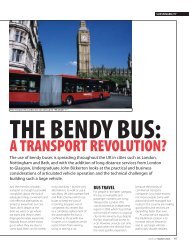
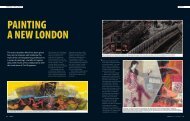
![[322/03] Francke - Ingenia](https://img.yumpu.com/23411337/1/184x260/322-03-francke-ingenia.jpg?quality=85)

